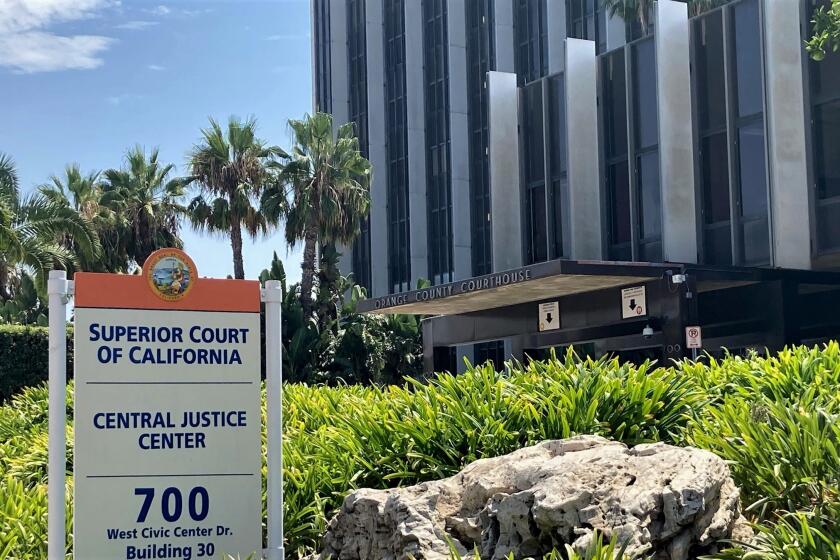CLOSER LOOK -- Debating whether wider is better
- Share via
Jennifer Kho
COSTA MESA -- Side by side, the two maps of the East 17th Street plans
look the same.
They both show a four-lane street, with a signal at Westminster
Avenue, right and left turn lanes, bus turnouts and landscaped medians.
The sole difference is indiscernible, a matter of only a few feet’s
width in the turn lanes at Orange Avenue.
But some business owners -- such as East 17th Street Merchants and
Community Assn. members and the majority on the city’s East 17th Street
Ad Hoc Committee -- say they see major divergence in the futures where
each plan could lead.
Merchants see “Plan B,” with its narrower turn lanes and bus bays --
between 10 and 10 1/2 feet wide -- as the spark needed to turn at least
part of the street into a pedestrian-oriented shopping village.
In contrast, they view “Plan E,” the plan with wider turn lanes and
bus bays -- between 11 and 13 feet wide -- as only a temporary change
until another council votes to add two lanes to the street, making it a
thoroughfare that commuters will speed along, endangering pedestrians and
shoppers.
“The plan we chose fulfills all the requirements we need for 17th
Street at this time,” said William Ross, owner of The Starving Artist and
a member of the ad hoc committee. “It will enhance the street and turn it
into a real shopping village. The problem with Plan E is the fact that
it’s still four lanes but would widen the street out at the corners in
anticipation of further widening in the future. I don’t think businesses
could survive if the street is torn up for the length of time it would
take to widen the street.”
THE FINANCIAL PERSPECTIVE
But regular traffic lanes are required to be wider than turn lanes,
said Peter Naghavi, transportation services manager for the city.
If Plan B is selected, the narrower turn lanes and bus bays could
increase costs in the future, Naghavi said, adding that if the City
Council later decides to convert the street to six lanes, the city could
not use those lanes until it tears out curbs.
“In the future, if criteria is met, we have to look at six lanes,” he
said. “We can’t just turn our heads and hide. If we go with Plan E and we
later decide to make it six lanes, we won’t have to spend a lot of
taxpayers’ money to knock out the new improvements.”
The ad hoc committee last week voted to recommend Plan B to the
council anyway, choosing a plan that could block future attempts to widen
17th Street into six lanes.
But Naghavi and City Councilman Gary Monahan say while both plans lead
to the same destination, in their opinion there is one practical
difference: Plan B might never get done, while Plan E has a better
chance.
The Orange County Transportation Authority in 1999 pledged to
distribute close to $4 million in federal grant money, if the street is
widened from four to six lanes.
Although the city will not get the entire amount for either of the
four-lane alternatives, the city could still be eligible for enough to
cover at least the design costs if the council chooses Plan E.
Naghavi estimated the design part of the grant money at about
$250,000.
“I think both plans are very quality projects and my hope is that one
or the other will be able to be built,” Monahan said. “Both have high
price tags in the $3 million to $4 million range. Where the money is
coming from I don’t know. We’re going to have to apply to the OCTA either
way. We probably wouldn’t qualify under Plan B but would have a higher
chance of getting funding for Plan E. The only difference is wider turn
lanes.”
But the threat of money isn’t enough to convince many business owners.
Brent Hemphill, owner of Hemphill’s rugs and carpets and a member of
the merchants association, said he believes there are other ways for the
project to be financially viable, such as through bonds or a donation
program.
GOING EITHER WAY
Charlotte Johnson, a Costa Mesa resident on the ad hoc committee who
voted for Plan B, said she could have supported either alternative.
Both plans have the qualities that were important to her -- left and
right turn lanes and signals.
She went with Plan B because she didn’t think the majority of the
committee would support Plan E, she said, adding that she is against
widening the street to six lanes and would like to discourage commuters
from further crowding the busy street.
“I live a little more than a block off of 17th Street and it’s a crazy
street,” she said. “It’s inhuman, it’s too fast, and we don’t need it to
be any faster or busier. I saw a woman get hit walking across the street.
It doesn’t need to be six lanes. I don’t want to live next to that. It
would just be a corridor for people going from one city to another.”
But Johnson said she knows that the street might eventually have to be
widened anyway and she admitted the wider-street alternative could be
more sensible, considering the money that would be available for its
design.
Naghavi said the decision also is a matter of regional responsibility.
The city has already downgraded two other streets, 19th Street and 22nd
Street, based on the assumption that 17th Street is widened.
“The fact is, it’s not just Costa Mesa,” he said. “We are part of the
region and have to be connected to the rest of the region. If you go out
of Costa Mesa, there is not a wall, it’s a seamless operation. It’s like
if Newport Beach wanted to downgrade PCH to two or four lanes. We
wouldn’t allow it. That’s why we have a master plan; because these
changes impact the entire region.”
The traffic has to go somewhere and if it is not 17th Street, it will
be residential streets, he said.
According to a 1997 study, between 40% and 60% of residential traffic
on the Eastside is cut-through traffic.
A HISTORY OF DISPUTES
The narrow divide between the plan that Naghavi recommends and the one
supported by the ad hoc committee is the result of 14 months of
discussion and compromise.
The dispute between the two alternatives is a much tamer version of
the heated disagreement that emerged at the beginning of discussions,
when the city formed the ad hoc committee of merchants and homeowners to
discuss plans for widening East 17th Street from Orange to Irvine
avenues, Naghavi said.
“From day one, it was obvious that the business members don’t want six
lanes and I do,” he said. “I think we’ve come to a good compromise in
Plan E. It provides what they want and allows us to be prepared in case
we want to widen to six lanes in the future.”
The plan to widen the street has been part of the city’s plan for
dealing with increasing traffic on the street since 1957.
The county’s traffic plan differs, requiring six lanes only from
Orange to Santa Ana avenues.
Merchants and residents, who in May formed the East Side Community and
Merchants Assn. to oppose the plan, said either plan would be detrimental
to business and to the nearby neighborhoods.
“The city wanted to make it into a six-lane highway and we don’t want
six lanes,” Hemphill said. “What needs to happen now is the whole thing
needs to be downgraded to four lanes all the way through, so no future
city council will get it into their heads to make it six lanes. Then we’d
have to go through this whole thing all over again.”
Options that have been discarded by the committee include not only the
six-lane plan, but also a five-lane plan and a hybrid plan matching the
county’s general plan.
TOO CLOSE TO PREDICT
Hemphill said he is confident Mayor Libby Cowan and council members
Karen Robinson and Chris Steel, who signed papers stating their
opposition to widening the street to six lanes when they were campaigning
last year, will vote for Plan B.
As of press time, the City Council decision was unpredictable. Monahan
is leaning slightly toward the plan with wider turn lanes and bus bays.
Councilwomen Linda Dixon and Karen Robinson are favoring the plan with
narrower turn lanes and bus bays. Mayor Libby Cowan is undecided, and
Councilman Chris Steel was unavailable for comment.
Dixon and Robinson said they are in favor of Plan B, but have not
completely made up their minds because they have not yet finished reading
all the information provided by city staff.
“I have not seen or heard of anything that has convinced me that six
lanes are needed on 17th Street,” Dixon said. “I don’t think even
homeowners on the Eastside are in support of six lanes. While we need to
work to improve 17th Street so traffic flow is easier and quicker, I
don’t think we should take away from the character of 17th Street and
make it a superhighway with six lanes just to move another city’s traffic
through our city.”
All the latest on Orange County from Orange County.
Get our free TimesOC newsletter.
You may occasionally receive promotional content from the Daily Pilot.








